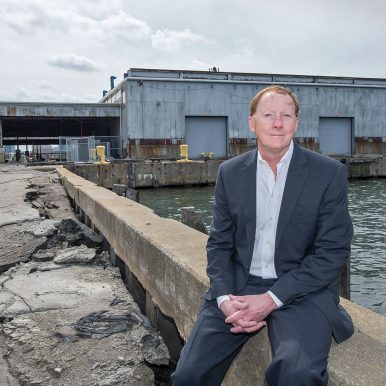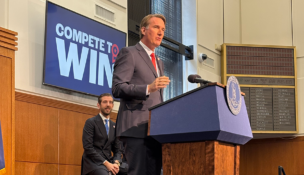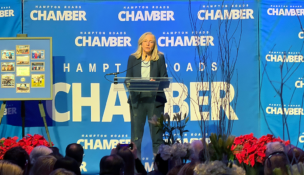Vantage point
Norfolk looks to transform existing real estate
Emily Freehling //September 29, 2022//
Vantage point
Norfolk looks to transform existing real estate
Emily Freehling //September 29, 2022//
Norfolk leaders have high hopes for redevelopment projects that will reposition older properties — from an aging mall to an underused marine terminal — to better match modern market demands.
“We are always asking, ‘What can we do that allows for some sort of creative transformation to actually happen?’” says Sean Washington, the city’s acting director of economic development.
Washington was appointed acting director of economic development in August after former director Jared Chalk left to become chief business development officer at the Hampton Roads Alliance.
Both Chalk and Washington have been closely involved in the city’s efforts to redevelop the Military Circle Mall retail complex.
Norfolk’s economic development authority purchased the mall and an adjacent hotel in April 2020 at a combined cost of $13.4 million. The EDA plans to demolish the mall in early 2023, as Norfolk City Council members continue to wrestle with what the property’s future holds.
Located near interstates 64 and 264, and near the $93 million Sentara Brock Cancer Center that opened in 2020, the mall is primed for redevelopment.
“With that being the high ground of the city, there is already an abundance of retail activity in that corridor, and great surrounding neighborhoods,” Washington says. “When you think about all those variables, it’s important for the city to be very strategic about what that area is going to look like in the coming decades.”
After soliciting proposals in late 2020 to redevelop the 74-acre complex, the city announced in August 2021 it was considering proposals from three development groups.
Progress then stalled, to the degree that the EDA returned deposits to developers in June, an acknowledgement of the longer-than-normal selection process. Then, in July, city leaders confirmed that Norfolk had entered “preliminary negotiations” with one of the three finalists — Wellness Circle LLC, the proposal from music superstar Pharrell Williams‘ team — but they still maintain that no final selection has been made.
“Like any big site like this, it’s going to take time,” says Chalk, who was interviewed for this story before he left his position as economic development director. “What we are trying to do is not build something like a mall with a 20- or 30-year shelf life. We are trying to create a district that is going to grow and contract with the economies.”
In addition to Williams, the Wellness Circle partnership includes concert company Live Nation and Virginia Beach developers Armada Hoffler Properties and Venture Realty Group. Their proposal — valued at $1.1 billion in May 2021 — includes a 15,000-plus-seat arena, 1 million square feet of office space, a 200-room hotel, retail and restaurant space, green space and residential development, including market-rate and low-income multifamily housing, as well as townhomes.
Wellness Circle would also include a second location of Williams’ independent Yellowhab elementary school, serving children who qualify for free or reduced lunch. In fall 2021, a Yellowhab pilot school opened in the city’s Ghent neighborhood, and Williams has said he hopes to spread the concept beyond Virginia to New York and Arizona.
Representatives from the Wellness Circle partnership declined to comment for this story, citing ongoing negotiations with the city.
A second finalist, Crossroads Partnership, includes Virginia Beach-based S.B. Ballard Construction Co. and the real estate company owned by Pro Football Hall of Famer Emmitt Smith. Crossroads’ $900 million proposal includes a 15,000-seat arena, parks and trails, an indoor sports complex, a 128-room hotel, medical offices and residential and retail space. Ballard representatives also declined comment.
A third proposal, submitted by Norfolk MC Associates LLC, which includes Virginia Beach-based hospitality company Gold Key | PHR and The Franklin Johnston Group, a Virginia Beach development company, proposes an 8,000-seat outdoor amphitheater instead of an arena, in addition to a hotel, retail, housing, office and green space. Dubbed “The Well,” this proposal was valued at $663 million when submitted. Bryan Cuffee, a vice president with Gold Key | PHR, which is behind Virginia Beach’s Cavalier Resort and The Main hotel in Norfolk, says the plan would require the least amount of investment from the city.
All three proposals involve the use of tax-increment financing, which commits future tax revenues generated by a development to help finance it, but building an arena could require additional public participation for infrastructure and other costs.
“Although the city has continued to express interest in an arena, at the end of the day the decision will be determined by the economics and financing, which will be difficult for an arena proposal to achieve,” Cuffee says.

High energy
Adjacent to Norfolk Southern Corp.’s coal terminal on the Elizabeth River is Fairwinds Landing, a new project at the Lambert’s Point Docks. Plans call for a $100 million maritime operations and logistics center to support the regional offshore wind, defense and transportation industries. Fairwinds Landing LLC, an entity linked to Virginia Beach-based The Miller Group, has a 30-year lease on the property owned by Norfolk Southern and began its occupancy Aug. 1.
Mike Hopkins, managing director for Fairwinds Landing LLC, says construction on Phase 1 of the project is expected to begin in early 2023, and his group is in negotiations with a “marquee” tenant in the offshore wind industry, with an announcement expected soon.
Tax credits made available to the renewable energy industry through the newly passed federal Inflation Reduction Act, which promises $369 billion in federal energy and climate spending, could help move the development along faster, Hopkins says.
“In our discussions with equipment manufacturers in offshore wind looking to come into the U.S., they have been kind of waiting to see how these tax incentives were going to break,” he notes. “I think it will spur some activity now that there is more favorable tax treatment for projects and manufacturers.”
In addition to supporting wind energy projects along the mid-Atlantic, such as Dominion Energy Inc.’s $9.8 billion Coastal Virginia Offshore Wind farm, Hopkins says, “we have had inquiries from companies who will be supporting offshore wind projects in the Northeast.”
The 111-acre Fairwinds Landing development, he adds, will have strong linkages with the offshore wind-focused redevelopment of the Portsmouth Marine Terminal just across the river, where Siemens Gamesa Renewable Energy S.A. is building the first U.S. factory to manufacture turbine blades for the massive offshore wind farms.
“We believe that synergy will have a ripple effect throughout the region for economic development to support the offshore wind industry in general, particularly given the strengths the area has with shipbuilding and ship repair, which have a lot of overlap with offshore wind,” Hopkins says.
Gaming gets rolling
Another waterfront area primed for redevelopment is expected to invigorate the city’s tourism sector.
The $500 million HeadWaters Resort & Casino is being developed by the Pamunkey Indian Tribe Gaming Authority on 13.4 acres along the Elizabeth River adjacent to Harbor Park Stadium, home of the Norfolk Tides Minor League Baseball team.
“It’s a piece of city property that is completely underutilized that will be not only a major generator of revenue for the city, but also a catalyst for additional economic development in the whole area,” says Jay Smith, a spokesman for the casino.
In September, the Pamunkey Indian Tribe submitted a site plan to the city to build a temporary casino on part of the property. The tribe expects to purchase the land and execute a development agreement on the property soon, according to Smith. The Pamunkey initially attempted to gain approval for a temporary casino at the city’s Harbor Park baseball stadium, but a paperwork error led city officials to table a vote in July.
The temporary facility will have all of the gaming activities of the eventual casino — including slot machines and table games — but on a smaller scale, Smith says. Construction of the temporary casino is expected to take six months and it will open after the tribe receives its gaming license from the Virginia Lottery.
Meanwhile, construction of the permanent casino and hotel will take 18 to 24 months. A groundbreaking date has not been set, but Smith anticipates a 2024 opening. Both the temporary casino and the permanent facility are expected to generate more than $30 million per year in gaming and sales taxes for the city.
Smith and city officials say the resort will be an important boost for city tourism, projected to attract 6.2 million visitors per year.
And it won’t be the only gaming facility in the area. About seven miles from the HeadWaters Casino location, the $300 million Rivers Casino Portsmouth owned by Rush Street Gaming is under construction, with a projected early 2023 opening.
Smith and Chalk both say the HeadWaters project is a higher-end destination that they expect will draw overnight visitors from a wide geographic area.
Chalk points to the other attractions Norfolk has developed near its waterfront — including the cruise terminal, the Nauticus maritime museum and the Waterside District’s restaurants, hotels and entertainment venues — as “a collection of catalytic assets” that will help draw tourists from outside of Hampton Roads.
To the degree that happens, the casino will have a net-positive economic impact on the region on top of the estimated new tax revenues for the city, says Vinod Agarwal, deputy director of the Dragas Center for Economic Analysis and Policy at Old Dominion University. However, an analysis the center released in 2021 predicts that the Portsmouth and Norfolk casinos will draw the vast majority of their business from in-state customers.
Agarwal says Portsmouth and Norfolk can expect to lure some customers from northeast North Carolina, and as long as voters in the Richmond area don’t approve a casino in 2023, the two resorts will also draw visitors from Northern Virginia and other markets that might otherwise drive to Richmond.
But “the magnitudes of those flows are estimated to be very small,” Agarwal says, noting that one positive for taxpayers is that neither facility is publicly supported. “The cities of Norfolk and Portsmouth will gain, but cities close by will lose some economic impact because the expenditures on leisure activities in those cities will be lower.”
However, Washington says there’s great value in the boost the HeadWaters project will bring to Norfolk’s overall tourism profile.
“We have a great opportunity to tell a bigger story,” he says. “It sends a larger message outside of our region, and even outside of the state, that attractions like this can exist here.”
In addition to the redevelopment projects underway, Chalk also points to the city’s success in encouraging existing employers to expand. In April, Fairfax-based military contractor WR Systems announced it would expand its Norfolk campus, a move that is expected to create 200 jobs, according to the Virginia Economic Development Partnership. Also in April, medical device company Embody Inc. announced a $5 million planned expansion to its facilities at Innovation Research Park at ODU, expected to add 92 jobs.
And after a two-year pause due to the pandemic, the first cruise ship departed from Norfolk’s Half Moone Cruise and Celebration Center in May, kicking off what Chalk says has been the city’s busiest-ever cruise season.
This combination of tourism and industrial assets, along with Norfolk’s status as the largest compact urban center in the Hampton Roads region, gives the city a host of tools as it seeks to secure its economic future, Washington says.
“That’s what adds that additional character to our city. There’s always going to be a certain end product that you can’t find anywhere else in this region.”
Norfolk at a glance
Located at the mouth of the Chesapeake Bay, Norfolk’s vast waterfront acreage has earned it the nickname of “the Mermaid City.” Home to Naval Station Norfolk — the world’s largest naval base — the city has capitalized on its strategic location as a hub of both defense and international shipping. Over the years, Norfolk has grown beyond its maritime roots, developing a vibrant food and entertainment scene.
Population
238,005
Top employers
U.S. Department of Defense
(10,000-plus employees)
Sentara Healthcare
(7,500 to 9,999 employees)
Norfolk Public Schools
(7,500 to 9,999 employees)
City of Norfolk
(2,500 to 4,999 employees)
Old Dominion University
(2,500 to 4,999 employees)
Major attractions
Downtown Norfolk offers numerous entertainment options, from the Nauticus maritime museum and Battleship Wisconsin to the Waterside District‘s restaurants. The nationally recognized Chrysler Museum of Art straddles the border between downtown and the historic Ghent neighborhood.
Top convention hotels
Sheraton Norfolk Waterside Hotel
– 466 rooms, 46,000 square feet
of event space
Norfolk Waterside Marriott –
405 rooms, 43,683 square feet
of event space
Hilton Norfolk The Main –
300 rooms, 61,824 square feet
of event space
Professional sports
Norfolk Tides — Minor League
Baseball (Baltimore Orioles
affiliate)
Norfolk Admirals — East Coast
Hockey League
On the horizon
The $500 million HeadWaters Resort & Casino expects to begin constructing a temporary gaming facility in late 2022. Norfolk also plans a multidecade makeover of Military Circle Mall into an entertainment and employment district that could include a major new arena.
r
















